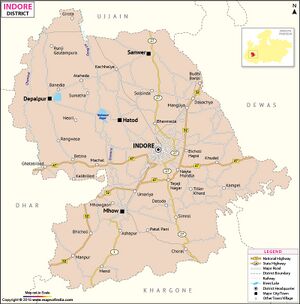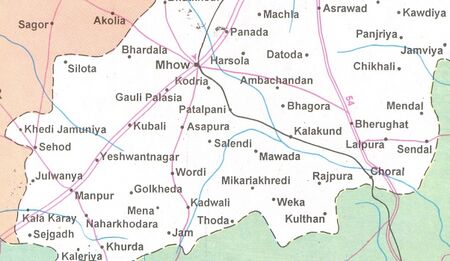Mhow

Mhow (महू) is a small cantonment town in the Indore District of the Malwa region of Madhya Pradesh state, India. It is located 23 km south of Indore city towards Mumbai on the Agra-Mumbai Road.
Jat Gotras
Etymology
There is total lack of unanimity on how Mhow got its name. There are many theories about this. But there is no confirmation about which theory is true. Here are some of these in no particular order.
(1) MHOW stands for 'Military Headquarters Of War'.
(2) MHOW stands for 'Military Headquarters Of Western India'
(3)It is said that the village near Mhow has been called Mhow Gaon since time immemorial. Thus the Cantonment which came up in 1818 came to be known as Mhow Cantt.
(4) The mahua tree which grows in profusion in the forests around Mhow has also been mentioned as a possible source for the name of this town.
Villages in Mhow tahsil

Ahilyapur, Akawi, Amba Chandan, Ambada, Anwalipura, Anwaliya, Ashapur, Awlay, Badgaon, Badgonda, Badiya, Badkuwa, Badoda Sindh, Bai, Baika, Banjari, Baradiya, Bardari, Barkheda, Barkheda, Basipipri, Berchha, Bhagora, Bhanbardi, Bhardala, Bhatkhedi, Bherughat, Bheslay, Bhicholi, Bhilani, Bhoj Karadiya, Biram, Borkhedi, Borkhedi, Borkhedi, Buraliya, Chasya, Chenpura, Chhapariya, Chikhli, Choral, Chordiya, Damali, Datoda, Dhawadiya, Dongargaon, Durjanpura, Gadaghat, Gajinda, Gangaliya Khedi, Gavhalu, Gawali Palasya, Ghoda Khur, Godkuwa, Gokanya, Gokanya Kund, Golkheda, Gopalpura, Gosi Kheda, Gunjara, Guwadi, Harnya Khedi, Harsola, Hasalpur, Imalipura, Jafra Bad, Jakhu Khedi, Jam Buzurg, Jam Khurd, Jamanya, Jamanya, Jamli, Jhikadiya Khedi, Joshi Guradiya, Julwaniya, Kadwali, Kalikirai, Kamadpur, Kaneriya, Kankriya, Kapar Kheda, Karadiya, Kawti, Kekariya Dabri, Kelod, Kesar Bardi, Kharda Kheda, Khedi (Istmurar), Khedli, Khudalpura, Khurda, Khurdi, Kodiya, Kodriya, Kolani, Kulamba, Kulthana, Kumti, Kurada Khedi, Kushalgarh, Kuwali, Lalpura, Lodhiya, Madhawpura, Malendi, Malipura, Mangalya, Manpur (NP), Matlabpura, Memdi, Mend Mend Mazra, Mendal, Mhow Cantt (CB+OG), Mhowgaon (NP), Nachanbor, Nahar Khedi, Nahar Khodra, Nanded, Nandgaon, Nandlai, Nawada, Nawadiya, Neu Guradiya, Olani, Ounouwa, Panda, Panjariya, Patal Pani, Pathan Pipalya, Phafund, Phut Talab, Pigdambar, Pipal Khut, Pipalya, Pipalya Lohar, Piplya Malhar, Raikunda, Rajpura, Rajpura, Ramgarh Palasghat, Rampuriya, Rampuriya Bujrg, Rampuriya Khurd, Ras Kundiya, Ratwi, Richhabardi, Santer, Sejgarh, Sendal, Shahda, Sherkund,, Sherpur, Shivnagar, Shrikhandi, Sihod, Silotiya, Simrol, Sitapat, Sonway, Surtipura, Sutar Khedi, Telanbardi, Thawlay, Tihi, Tinchha, Umariya, Umeth, Utediya, Yashwantnagar,
History
This cantonment town was founded in 1818 by Sir John Malcolm as a result of the Treaty of Mandsaur between the English and the Holkars who ruled Indore. Sir John Malcolm's forces had defeated the Holkars at the Battle of Mahidpur in 1818. It was after this battle that the capital of the Holkar Kingdom shifted from the town of Maheshwar on the banks of the Narmada to Indore. Mhow used to be the headquarters of the 5th Division of the Southern Army (a Division comprising only British units) during the British Raj. Today this small town is associated with the Indian Army and with Dr. Bhimrao Ramji Ambedkar (1891-1956), the father of the Indian Constitution who was born here.
Places of interest
Mhow is famous for its mild and pleasant weather, unspoilt countryside and the cool evening breeze known as Shab-e-Malwa which makes the summers less harsh and so much more tolerable. Some of the picnic spots in and around Mhow are: Patal Pani waterfalls, Choral dam, Nakheri dam, Beircha lake, the lakes near Mhow fort, Yashwantnagar Talaab, Janapav temple in Kuti Village, Sitlamata temple and falls (in Manpur, 20 km from Mhow), Jam Darwaza (12 Km from Mhow towards Maheshwar), Bhagoda Water falls (Mhow-Simrol Road).There is also a very old Durga temple at Mhow Gaon.
Eight kilometres from Mhow is the industrial estate of Pithampur which falls in the adjoining Dhar district. Pithampur is a hub for the automobile manufacturing industry and in addition to major units like Kinetic Honda, Hindustan Motors and Bajaj Tempo Ltd. it has many ancillary units.
Demography
Mhow tehsil is supposed to have a population of around 2,00,000. This includes the villages around Mhow which together form an administrative unit and is looked after by a team headed by the Sub Divisional Magistrate (SDM).
As of 2001 India Census, Mhow Cantonment had a population of 85,023. Males constitute 54% of the population and females 46%. Mhow Cantonment has an average literacy rate of 72%, higher than the national average of 59.5%: male literacy is 78%, and female literacy is 65%. In Mhow Cantonmment, 12% of the population is under 6 years of age.
This small town has representatives of almost all communities. The Bhils who are the original inhabitants of this area still live in villages scattered around Mhow.
The villages of Mhow (and Malwa) especially Gawli Palasiya, Kodariya, Kelod, Jamli, Badgonda and Harsola have a large number of Patidars who are originally from Gujarat. The Patels of Gujarat are a part of the Patidar community. Mhow has a sizable number of Marathis as it is part of Indore, the erstwhile state ruled by the Maratha Holkar family.
Jats around Mhow
This area has a good population of Jats. People from nearby villages of Merta city migrated to Indore, M.P. and now highly educated and some of them settled in USA. These basically belong to Karwasraon ki dhani and settled in Village Harsola, Teh. Mhow Dist Indore, M.P.
Among the various communities settled in Mhow some have a distinctive Raj connection; these include the Parsis or Zoroastrians,the Goan Catholics, the Anglo Indians, a community of Hyderabadi Muslims and the Ahir Muslims of Banda Basti.The first three communities are very small numerically.
The Parsis who were a thriving community at one time have now become a very small community in Mhow. They have a fire temple in Mhow town and a Tower of Silence where they keep their dead. The Tower of Silence is between Mhow and the Beircha Lake. The Parsis are very intimately connected with the growth and evolution of modern Mhow.
Mhow has a large number of Muslims, this includes both Shias and Sunnis. Mhow also has a substantial number of Dawoodi Bohras - a sub-sect of Shīˤa Muslims from Gujarat who are mostly businessmen by profession. Besides the Dawoodi Bohras, the business communities in Mhow includes Marwaris,Punjabi Hindu Aroras, Sindhis, Jains and Gujaratis. The Sikhs also have a presence in Mhow, many of them having arrived here after the partition of 1947 along with the Hindu Punjabis. Each community listed above has contributed in its own way towards the growth of Mhow.
The Indian Army and Mhow
Mhow and the Indian Army are inseparable. The Army has been here since 1818. Till World War II Mhow used to be the headquarters of the 5th Division of the Southern Army (a Division comprising only British units). According to local legend Winston Churchill had also spent a few months in Mhow when he was a subaltern serving with his regiment in India. The house on the Mall where he is supposed to have lived has gradually crumbled due to neglect and age. It has been pulled down and a jogger's park has been built on its grounds by Infantry School Mhow.
Mhow is synonymous with the Indian Army and has been a training centre of the Army since the British days. It houses three premier training institutions: (i) The Infantry School - the alma mater of the Indian Infantry which is the spearhead of the Indian Army (ii) The Military College of Telecommunication Engineering (MCTE), the alma mater of the Corps of Signals. The Corps of Signals is like the nervous system of the Indian Army as it is responsible for communications. (iii) The Army War College(formerly known as the College of Combat). These three institutions together form the backbone of Mhow. Each of these institutions is headed by a Lieutenant General.
Notable persons
- Amit Kumar Pilania -
- Satish Mandia, police inspector- 9826010508
- Shashi kant Bagadia, Bank officer- 9826572562- 7389495677
- Ramauvtar Choudhari- 9753082087
External links
Source
- Santosh Kumar Thakur (Khenwar)mob.9826546968
References
Back to Jat Villages

